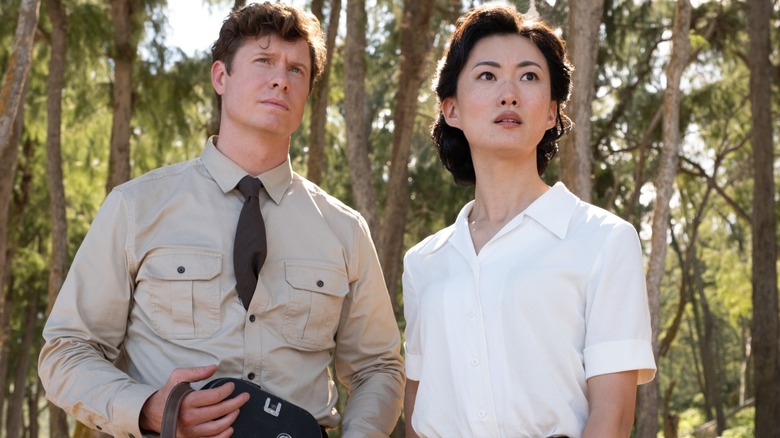Forget Godzilla: Monarch Episode 3's Explosion Was More Terrifying In Real Life
Contains spoilers for "Monarch: Legacy of Monsters" Season 1, Episode 3 — "Secrets and Lies"
The "Godzilla" franchise is no stranger to imbuing the fiber of its fantastical lore with real-world history, and the Apple TV+ series "Monarch: Legacy of Monsters" continues this trend with a key moment in Episode 3, "Secrets and Lies."
In 1954, Lieutenant Lee Shaw (Wyatt Russell), Dr. Keiko Miura (Mari Yamamoto), and cryptozoologist Bill Randa (Ander Holms) manage to convince the American military to fund their efforts to locate massive unidentified terrestrial organisms following their discoveries in the Philippines. However, the team's request for a surplus of uranium to attract and study one of these creatures is answered with a nuclear bomb on Bikini Atoll. Their attempts at getting the army to back down from launching the super weapon are unsuccessful, and eventually, Godzilla rises from the depths to investigate, resulting in his apparent death.
But the fictional event doesn't hold a candle to the devastation brought about by the real-world tragedy that inspired it. Among the many nuclear bomb tests done in the aftermath of World War II was Operation Castle, which consisted of a series of six detonations on Bikini Atoll in 1954. The first, Castle Bravo, yielded far greater results than predicted, with the blast destroying measuring equipment and the resulting fallout doing sustained damage to communities in the surrounding Marshall Islands.
Castle Bravo partially influenced Godzilla's creation
Castle Bravo inspired not only the scene in Episode 3 of "Monarch: Legacy of Monsters" but also the 70-year-spanning franchise itself, with the destruction it caused informing the strong message of the original "Godzilla" film.
Predicted to deliver six megatons of power, the test ended up yielding 15, making it the single most powerful thermonuclear device launched by the United States. Despite being over 80 miles away from the test site, the 23 crew members of the Japanese fishing vessel Lucky Dragon No. 5 found themselves affected by the radioactive fallout from the explosion, with one of them eventually dying as a result.
The incident created shockwaves across Japan, helping birth a strong anti-nuclear movement throughout the country. Director-writer Ishiro Honda took heavy inspiration from the tragic event for "Godzilla," particularly the scene showcasing a ship full of men being incinerated by a nuclear blast.

